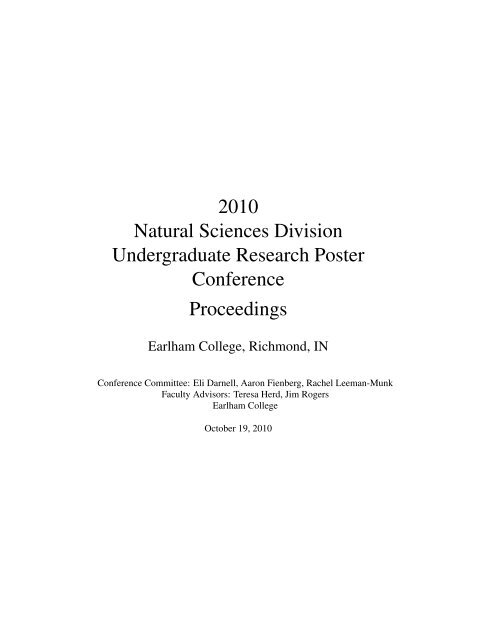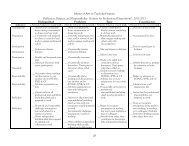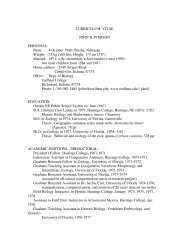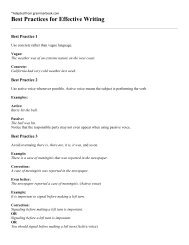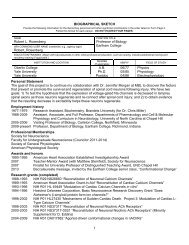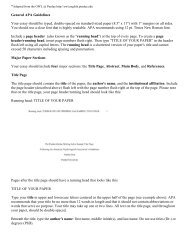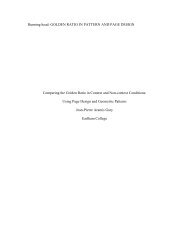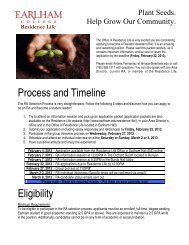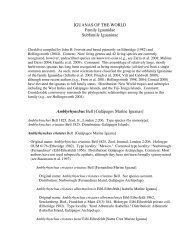Earlham College, Richmond, IN - Earlham Computer Science ...
Earlham College, Richmond, IN - Earlham Computer Science ...
Earlham College, Richmond, IN - Earlham Computer Science ...
Create successful ePaper yourself
Turn your PDF publications into a flip-book with our unique Google optimized e-Paper software.
2010<br />
Natural <strong>Science</strong>s Division<br />
Undergraduate Research Poster<br />
Conference<br />
Proceedings<br />
<strong>Earlham</strong> <strong>College</strong>, <strong>Richmond</strong>, <strong>IN</strong><br />
Conference Committee: Eli Darnell, Aaron Fienberg, Rachel Leeman-Munk<br />
Faculty Advisors: Teresa Herd, Jim Rogers<br />
<strong>Earlham</strong> <strong>College</strong><br />
October 19, 2010
URPC Proceedings<br />
URPC-ii
URPC Proceedings<br />
Conference Program<br />
Tuesday October 19, 2010<br />
Poster Session<br />
1 Geometry Optimization and Reaction Energy Analysis of Transition Metal<br />
Complexes Using Density Functional Theory<br />
1 Secondary Structural Investigation of Surfactant Peptide KL4 in Lipid Membranes<br />
Using FTIR<br />
2 Study of Ultrasound Interaction with Cells<br />
2 Analysis of JWH Analogs Used as Synthetic Cannabinoids in Incense Mixtures<br />
3 Music Generation and Variation from Cellular Automata, Chaotic Trajectories,<br />
and Reaction/Diffusion Systems<br />
3 The role of NrCAM in the development of the mouse visual pathway<br />
4 Refining the IVBSS<br />
4 Refining the Annotations of Malaria Genomes<br />
5 Drugs used to treat neuropsychiatric disorders affect α7 nicotinic acetylcholine<br />
receptors<br />
5 Antioxidant activity in Anise seed extracts<br />
6 Concentrations of Terpinen-4-ol in Multiple Brands of Melaleuca alternifolia<br />
Oil<br />
6 An Exploratory Screening of Achyrocline satureoids<br />
7 Reproductive traits of the Nebraska Spiny Softshell turtle (Apalone spinifera)<br />
with notes on geographic variation<br />
7 The Study of Natural Products: The Extraction and Isolation of Pau d’Arco<br />
UV Florescent Compounds<br />
8 Internship in the Exploration and Development Department at YPFB Chaco<br />
S.A., a Bolivian Oil Company.<br />
8 Using Oxygen Fugacity to Learn about the Chemical Evolution of the Bushveld<br />
Complex<br />
9 Extraction and Isolation of Organic Compounds in the Medicinal Herb Feverfew<br />
9 Gene expression during developmental differentiation of queen and worker<br />
castes in a harvester ant<br />
10 Synthesis of Selected Avenic Acid Analogs<br />
10 Spin Assignments in Selenium-71<br />
11 Cognitive Complexity of Linguistic Patterns<br />
11 Analysis of Jergon sacha<br />
URPC-iii
URPC Proceedings<br />
12 The Effects of Ultraviolet and Visible Spectrum Coloration on Predation Risk<br />
of Lepidopteran Larvae<br />
12 Identification of Basaltic Clasts in Lunar Meteorites: In Search of South Pole-<br />
Aitken Basin Material<br />
13 The Late Bronze Age in Ukraine: Preliminary results from the Rozanivka site<br />
13 The Tracking of Regions of Interest in Sample Phantoms Using Deformation<br />
Compounding.<br />
15 List of Authors and Faculty Advisors<br />
URPC-iv
URPC Proceedings<br />
Geometry Optimization and Reaction Energy Analysis of Transition<br />
Metal Complexes Using Density Functional Theory<br />
Tiffani Henn, Erin McIlvain, Evelyn Tandy, Lori A. Watson †<br />
Department of Chemistry<br />
<strong>Earlham</strong> <strong>College</strong>, <strong>Richmond</strong>, <strong>IN</strong> 47343<br />
watsolo@earlham.edu<br />
Density Functional Theory (DFT) provides a good method to computationally investigate<br />
the electronic and molecular structure of transition metal compounds and to obtain<br />
reaction energies and energetic comparisons of competing isomers. This project used DFT<br />
(B3LYP) as implemented in Gaussian03 and Gaussian09 to calculate a variety of oxo and<br />
imido tungsten and rhenium complexes that had been synthesized during previous research<br />
in the group. Various isomers were calculated in order to predict and/or confirm the experimentally<br />
obtained structure, and the thermochemistry of several reactions were examined.<br />
Optimized geometries of each complex were obtained, providing information on the degree<br />
of unsaturation at the metal center. Molecular orbital calculations were undertaken to<br />
provide insight into future reactivity studies.<br />
Secondary Structural Investigation of Surfactant Peptide KL4 in Lipid<br />
Membranes Using FTIR<br />
Karman J. Duchon, Jessica R. Jensen, Kalani J. Seu †<br />
Department of Chemistry<br />
<strong>Earlham</strong> <strong>College</strong><br />
National Road West<br />
<strong>Richmond</strong>, <strong>IN</strong> 47374<br />
seuka@earlham.edu<br />
The structure and dynamics of membrane proteins are integral to understanding protein<br />
function. Membrane peptide interactions play a key role in cell function, as hydration<br />
states of peptides can alter both the structure and function of the peptide. The goal<br />
of this project is to investigate the secondary structure of the surfactant peptide KL4 in<br />
a lipid environment using FTIR spectroscopy. This twenty-one amino acid peptide was<br />
incorporated into lipid vesicles of varying compositions and the thermal unfolding of the<br />
peptide was monitored over a variety of temperatures. Additionally, the incorporation of<br />
specific isotope-labeling provided molecular level resolution of the peptide conformation<br />
and backbone-solvent hydrogen-bonding. The results of this work will be discussed.<br />
URPC-1
URPC Proceedings<br />
Study of Ultrasound Interaction with Cells<br />
Anan Suleiman, Peter McLarnan, Teresa Herd †<br />
<strong>Earlham</strong> <strong>College</strong><br />
asulei07@earlham.edu<br />
The goal of our research was to become familiar with acoustics measurements and<br />
eventually develop techniques that will allow us to explore diagnostic ultrasound imaging.<br />
Therefore in our experiments, we used tissue-like phantoms that consist agar with embedded<br />
glass beads. Different sized beads were used to simulate different scattering sizes.<br />
We measured several acoustic properties of samples. We focused on measuring the ultrasound<br />
propagation speeds and attenuation coefficients using a narrow band substitution<br />
technique, as well as measuring the backscatter coefficients (BSC) of different samples. In<br />
future studies, a cell pellet biophantom technique will be introduced, and applied to the<br />
ultrasonic backscatter estimate using Chinese hamster ovary (CHO) cells.<br />
Analysis of JWH Analogs Used as Synthetic Cannabinoids in Incense<br />
Mixtures<br />
Kate Waters, Yasmin Jaghab, Erin Litchfield, Gordon Lyman, Corinne Deibel †<br />
<strong>Earlham</strong> <strong>College</strong> Chemistry Department<br />
etlitch08@earlham.edu<br />
A Thin Layer Chromatography (TLC) method has been developed for the quantitative<br />
determination of three synthetic cannabinoids, JWH-018, JWH-073, and JWH-081,<br />
reported active ingredients in “Spice” mixtures. Optimum separation was achieved on C18<br />
EMD reverse phase plates using a 90/10 acetonitrile/water mobile phase. The plates were<br />
visualized at 366 nm and Rf values of .550 ± .002, .639 ± .002, and .548 ± .003 were found<br />
for JWH-018, JWH-073, and JWH-081 respectively. Standards of JWH analogs with concentrations<br />
of 5, 2.5, 1, 0.5, 0.25, 0.1, 0.05 and 0.025 mg/mL were prepared in ethylacetate<br />
and 1 microliter eluted on the C18 EMD plates. Using a Cannon Canon Digital Rebel XSi<br />
EOS 450D digital camera, these plates were imaged, and analyzed using Labview software.<br />
Preliminaries results suggest that the fluorescence intensity is related by power law to the<br />
concentration of the standard. Four different samples of “Spice” (Bayou Blaster, K2 Fruit<br />
Punch, K2 Orange, and K2 Summit) were washed with ethylacetate ( 100mg in .5 mL) to<br />
dissolve the sprayed active ingredient. 1 microliter of the resulting solvent was spotted on<br />
the C18EMD plate and ran in the same conditions as the standards. The plates indicated<br />
that a two of compounds that fluoresced at 366nm were present in the samples and one<br />
band was found to match the Rf value found JWH-018. Scanning electron microscope<br />
(SEM) images of the purchased “Spice” samples showed the presence of crystals on the<br />
plant matter.<br />
This work was funded by the Stephen and Sylvia Tregidga Burges Endowed Research<br />
Fund.<br />
URPC-2
URPC Proceedings<br />
Music Generation and Variation from Cellular Automata, Chaotic Trajectories,<br />
and Reaction/Diffusion Systems<br />
Thomas Morrill, Anand Pardhanani †<br />
<strong>Earlham</strong> Math Department<br />
tom.draws@gmail.com<br />
Music may be thought of as a sequence of pitches and chords, each discrete item in<br />
the sequence influencing pitches and chords that follow. This interconnectedness is also a<br />
key feature of cellular automata, where discrete cells fluctuate between states based on the<br />
states of their neighbors, chaotic trajectories, where a particle’s current position is reliant on<br />
its previous positions, and reaction/diffusion models, where complex patterns are formed<br />
based on the concentrations of interacting morphogens. This project aims to examine these<br />
systems as they apply to music—in generating new music and in creating variations upon<br />
existing pieces. Previous work has explored the use of strange attractors based on differential<br />
equation models to generate chaotic variations on a given musical piece. In this work,<br />
we extend some of these ideas by studying different mapping strategies as well as incorporating<br />
additional components of the musical piece. We demonstrate how simple changes<br />
to the starting conditions and rules of the systems result in drastic changes to the musical<br />
output.<br />
The role of NrCAM in the development of the mouse visual pathway<br />
Eli Darnell, Galina Demyanenko, Patricia Maness<br />
<strong>Earlham</strong> <strong>College</strong><br />
Department of Biochemistry & Biophysics, UNC-CH<br />
epdarne07@earlham.edu<br />
The visual pathway of the brain is composed of several sets of axon projections. Retinal<br />
ganglion cell (RGC) axons carry visual information from the retina to the Lateral Geniculate<br />
Nucleus (LGN) of the thalamus, the sensory relay center of the brain. Axons traveling<br />
to the dorsal LGN (dLGN) segregate into two sections: ipsilaterally (same side) projecting<br />
axons form the ipsilateral patch, and contralaterally (opposite side) projecting axons<br />
form the surrounding contralateral portion of the dLGN. The mapping of ipsilateral and<br />
contralateral axons from both eyes is crucial to the development of binocular vision. From<br />
the dLGN of the thalamus, axons map to the visual cortex, where visual information is<br />
processed. Axons travel both from the thalamus to the cortex (thalamocortical, TC), and<br />
back from the cortex to the thalamus (corticothalamic, CT). NgCAM related cell adhesion<br />
molecule (NrCAM) is important for axonal mapping, synaptic plasticity, and learning<br />
(Maness & Schachner, 2007). The NrCAM gene has been identified as a candidate gene<br />
for autism spectrum disorder (ASD) and schizophrenia, disorders which have associated<br />
visual defects. Here we investigate the role of NrCAM in retinogeniculate (RG), TC, and<br />
CT axon mapping of the visual pathway in a mouse model.<br />
URPC-3
URPC Proceedings<br />
Refining the IVBSS<br />
Matthew Jackson, Dillan Funkhouser † , Mary Lynn Buonarosa †<br />
UMTRI (University of Michigan Transportation Research Institute)<br />
mcjacks08@earlham.edu<br />
The IVBSS (Integrated Vehicle Based Safety Systems) is a crash warning system capable<br />
of forward collision, lateral drift, lane-change merge, and curve speed warnings. Cars<br />
equipped with this system as well as some audio and video recording equipment was given<br />
to just over 100 subjects. The goal of this study was to evaluate the effect of the system<br />
on the subjects driving, to determine the how frequently drivers performed secondary tasks<br />
and if drivers tended to perform secondary tasks during low or high risk situations. The<br />
video and audio data was sorted and coded in order to achieve these goals.<br />
Refining the Annotations of Malaria Genomes<br />
Emmalee Adelman, Alisha Harms, Janell Jensen, Chris Meserve, Martin<br />
Tinkerhess, William Vincent, Xander Rowland, Alfred Simkin, Lindsey<br />
Howlett,Gaya Hettiarachchi, Doug Armour, Caroline Hackett, David Courtney,<br />
Doug Hardesty, and Peter L. Blair †<br />
Biology Department<br />
<strong>Earlham</strong> <strong>College</strong><br />
<strong>Richmond</strong>, Indiana<br />
blairpe@earlham.edu<br />
Malaria remains a global scourge to human life and existence and is responsible for<br />
up to 500 million cases and 3 million deaths annually. Therefore the need to establish<br />
and design novel malaria drug and vaccine strategies is crucial yet remains challenged, in<br />
part, due to the current status of malaria gene annotations. While the human malaria (P.<br />
falciparum) genome deserves the majority of attention, the accuracy of the rodent model (P.<br />
yoelii) genome is imperative for the traditional pipeline of drug/vaccine development and<br />
validity studies. Our research utilizes published large-scale datasets, notably Expressed<br />
Sequence Tags (ESTs), comparative genomics, and bioinformatic approaches to resolve<br />
and correct the current P. yoelii gene annotations. To date our research group has examined<br />
1585 genes, 20.2<br />
URPC-4
URPC Proceedings<br />
Drugs used to treat neuropsychiatric disorders affect α7 nicotinic acetylcholine<br />
receptors<br />
Sean P. McGuire, Ross S. Price, Maryam A. Taheri, Robert L. Rosenberg †<br />
<strong>Earlham</strong> <strong>College</strong><br />
rosenbo@earlham.edu<br />
Nicotinic acetylcholine receptors (nAChRs) are ligand-gated ion channels that are pentamers<br />
of α and β subunits (α1-10, β1-4). nAChRs are expressed throughout the central<br />
nervous system, peripheral nervous system, and at the neuromuscular junction. Binding of<br />
the neurotransmitter acetylcholine or other agonists causes the ion channel to open, allowing<br />
influx of cations, and causing membrane depolarization. We focused on α7 nAChRs<br />
which modulate neurotransmission in the CNS, including dopaminergic and serotonergic<br />
pathways. nAChR activity plays a role in many neuro-psychiatric disorders such as depression,<br />
addiction, Alzheimer’s disease, Parkinson’s disease, schizophrenia, ADHD, and<br />
chronic pain. Our research examined drugs that are in use or in development for the treatment<br />
of these disorders. Specifically, bupropion is a dopamine/norepinephrine reuptake<br />
inhibitor used to treat depression and nicotine addiction. Zimelidine and fluvoxamine are<br />
selective serotonin reuptake inhibitors (SSRIs) used to treat depression. Gabapentin is<br />
used to treat neuropathic pain, epilepsy, and other disorders. Ziprasidone is used for treatment<br />
of schizophrenia and bipolar disease. The complete, detailed mechanisms of most<br />
of these drugs are still not completely understood. The goal of our research was to test<br />
the hypothesis that these drugs could modulate the activity of α7 nAChRs as part of their<br />
pharmacological action. We obtained evidence that bupropion and zimelidine are competitive<br />
inhibitors of α7 nAChRs and that fluvoxamine is a non-competitive inhibitor. The<br />
administration of gabapentin produced no significant change in channel activity. Thus, the<br />
pharmacological actions of some reuptake inhibitor anti-depressant drugs may include α7<br />
receptor blockade.<br />
Antioxidant activity in Anise seed extracts<br />
Philip Manasseh, Mike Deibel †<br />
Department of Chemistry, <strong>Earlham</strong> <strong>College</strong>, <strong>Richmond</strong>, <strong>IN</strong> 47374<br />
pamanas08@earlham.edu<br />
Anise seed (Pimpinella anisum) is a plant commonly used in the Mediterranean region.<br />
In this study, antioxidant activities of different extraction methods of anise seed were investigated.<br />
First, the optimum extraction method was found by running different TLC (Thin<br />
Layer Chromatography) plates in different solvents. Then, the antioxidant activity was<br />
evaluated using ABTS. This project was funded by <strong>Earlham</strong> Ford/Knight Endowed Fund.<br />
URPC-5
URPC Proceedings<br />
Concentrations of Terpinen-4-ol in Multiple Brands of Melaleuca alternifolia<br />
Oil<br />
Gordon Lyman, Michael Deibel †<br />
Department of Chemistry, <strong>Earlham</strong> <strong>College</strong>, <strong>Richmond</strong>, <strong>IN</strong> 47374<br />
gjlyman08@earlham.edu<br />
The percentages of terpinen-4-ol in six brands of Melaleuca alternifolia (tea tree) oil<br />
was determined using silica gel coated thin layer chromatography (TLC). This was meant<br />
to determine the quality of tea tree oil from multiple sources. The tea tree oil was diluted<br />
and micro-pipetted onto one TLC plate. A terpinen-4-ol standard was also micro-pipetted<br />
onto the same plate and treated with a p-anisaldehyde dip and heat treatment. The plate was<br />
then imaged and the data analyzed for the spot absorbency of each sample. The percentage<br />
of terpinen-4-ol remained consistent among all but one of the brands tested. The brand with<br />
a decreased amount of terpinen-4-ol was Neutracutical. The companies with similar concentrations<br />
of terpinen-4-ol were; AuraCacia, Thursday Plantation, Jason, Desert Essence<br />
and Now Personal Care. The amount of terpinen-4-ol in tea tree oil was, on average among<br />
the brands, found to be 28 ±4%. The average of terpinen-4-ol among the five brands with<br />
similar concentrations was 30 ±4%. This project was funded by <strong>Earlham</strong> Ford/Knight<br />
Endowed Fund.<br />
An Exploratory Screening of Achyrocline satureoids<br />
Lauren M. Shade, Michael A. Diebel †<br />
<strong>Earlham</strong> <strong>College</strong> Chemistry Department, <strong>Richmond</strong>, <strong>IN</strong> 47374<br />
lmshade07@earlham.edu<br />
Natural products have often been used as an alternative to prescription drugs. Although<br />
these natural remedies have not been FDA approved, many products contain phytochemicals<br />
that have been reported to treat various ailments. In this project an herb native to Brazil,<br />
Achyrocline satuureoids (Macela Powder), was explored to see if this naturally occurring<br />
product contained some of the properties that had been suggested. To test for the presence<br />
of these phytochemicals the herb was extracted in a variety of solvents. The extracted herb<br />
was then run on Thin Layer Chromatography (TLC) plates in various solvents to obtain a<br />
plate that showed desired separation. It was found that the best solvents for extraction were<br />
Acetone: Water (70:30) and Methanol. It was also determined that the best running solvent<br />
was methanol: dicholoromethane: acetic acid (0.7mL: 5mL: 1 drop). The TLC plates were<br />
then exposed to a series of qualitative as well as quantitative tests and processes including:<br />
an antimicrobial test, a phenolics test, an antioxidant test (DPPH dip), as well as an ABTS<br />
test. Macela powder was found to have considerably high antioxidant levels and was comparable<br />
to other natural product values found in similar research projects, such as green<br />
tea. The powder was then further evaluated for phenolic content and was comparable to<br />
products such as Blue Violet Leaf, Green Tea (Nature’s) and Red Root. Further research<br />
on Macela powder is needed in order to isolate individual compounds and determine their<br />
structures and properties. This project was funded by the <strong>Earlham</strong> Ford/Knight Endowed<br />
Fund.<br />
URPC-6
URPC Proceedings<br />
Reproductive traits of the Nebraska Spiny Softshell turtle (Apalone spinifera)<br />
with notes on geographic variation<br />
Matt Lachiusa, Ruthie Carter, John Iverson †<br />
Biology Department, <strong>Earlham</strong> <strong>College</strong>, <strong>Richmond</strong>, <strong>IN</strong> 47374<br />
recarter07@earlham.edu<br />
Spiny Softshells (Apalone spinifera) have the third largest range of any North American<br />
turtle species (Buhlmann et al. 2009). However, due to their elusive and highly aquatic life<br />
style, softshells are difficult to study, so many of the details surrounding their life history<br />
remain unknown. In this study and using data from previous studies, we attempted to<br />
answer questions about the reproductive traits of Spiny Softshells such as the number of<br />
clutches produced per breeding season, clutch size, relative egg mass, and whether these<br />
traits correlate to adult female size. In the summer of 2010, data was collected with the use<br />
of fyke nets to capture gravid females from Rattlesnake Pond in the Western Sandhills in<br />
Lewellen, Nebraska. These females were then measured and weighed, as well as x-rayed<br />
to determine clutch size. Findings from previous studies across North America were also<br />
compiled to ascertain whether these reproductive traits vary geographically. This research<br />
was supported by the Stephen and Sylvia Tregidga Burges Endowed Research Fund.<br />
The Study of Natural Products: The Extraction and Isolation of Pau<br />
d’Arco UV Florescent Compounds<br />
Benjamin Armour, Michael Deibel †<br />
<strong>Earlham</strong> <strong>College</strong><br />
bbarmour08@earlham.edu<br />
Determining the active compounds in herbal medicine is an important step towards<br />
evaluating the extent of their effectiveness. Pau d’Arco is a medicinal herb derived from<br />
the bark of a South American evergreen tree called Tabebuia avellanedae. This medicinal<br />
herb has been used for conditions such as candidiasis (a vaginal or oral yeast infection),<br />
herpes simplex virus, influenza, parasitic diseases, and a wide range of bacterial infections.<br />
There have also been studies on Pau d’Arco’s anti-cancer properties. The primary purpose<br />
of this project was to work with different extraction and separation methods to determine<br />
an ideal procedure for isolating some of the ultraviolet active compounds. This study was<br />
able to isolate different products from an extraction with dichloromethane and separation<br />
using TLC plates with three difference mobile phases. These results were replicated using<br />
the flash chromatography whereby extracts were fractioned off and then compared to TLC<br />
plates for identification. Once the extraction method and mobile phases had been established,<br />
three different compounds were identified based UV fluorescence. Additionally,<br />
p-anisaldehyde reagent was utilized in order to identify the presence of phenol groups in<br />
all three compounds. The presence of phenol groups provides a basis for future analysis of<br />
the Pau d’Arco herb. This project was funded by <strong>Earlham</strong> Ford/Knight Endowed Fund.<br />
URPC-7
URPC Proceedings<br />
Internship in the Exploration and Development Department at YPFB<br />
Chaco S.A., a Bolivian Oil Company.<br />
Alvaro Puente, Andrew Moore † , Meg Streepey †<br />
YPFB Chaco S.A.<br />
apuente07@earlham.edu<br />
The exploration and exploitation of oil reservoirs is a field that, has been, and still is<br />
growing in Bolivia. Taking into account that both geology and geophysics have an important<br />
role in these two processes, I decided to work as an intern for YPFB Chaco S.A.,<br />
an oil company based in Santa Cruz, Bolivia. During the three months, I worked mostly<br />
with the geophysics department on the planning of a 3D seismic profile acquisition project.<br />
Using the observer’s report data of previous 2D seismic projects I developed a statistical<br />
analysis of the regions, within the acquisition territory, in which the drilling of shot points<br />
was to be difficult. I found that 30% of the acquisition site had to be drilled with equipment<br />
more powerful than usually required. I also worked at a drilling camp assisting the<br />
head geologist in the analysis of samples obtained from the BBL 10 well which was still<br />
in the perforation stage. With this information it was possible to make a lithostratigraphic<br />
correlation between this well and two others, which had been previously drilled, and were<br />
completed and under production.<br />
Using Oxygen Fugacity to Learn about the Chemical Evolution of the<br />
Bushveld Complex<br />
Edward W. Marshall, Jill VanTongeren †<br />
AMNH REU 2010<br />
edmarshall4@gmail.com<br />
The chemical evolution of the Bushveld Complex and other layered igneous intrusions<br />
has long remained a mystery. Whether the Bushveld Complex evolves toward iron enrichment<br />
(Fenner trend) or silica (Bowen trend) is still unknown. This study seeks find which<br />
trend was followed in order to uncover the composition of the final residual liquid. Oxygen<br />
fugacity is one of indicators that can point to which evolution trend occurs. By discovering<br />
the oxygen fugacity of the Bushveld Complex one can deduce the evolution trend of the<br />
magma. Oxygen fugacity was calculated from magnetite–ilmenite pair compositions using<br />
the oxybarometers QUILF (Anderson et al, 2003) and the Fe-Ti Oxide Geothermometer<br />
(Ghiorso and Evans, 2008), and from vanadium in magnetites and clinopyroxenes using a<br />
relation between fugacity and the partition coefficient of vanadium in clinopyroxene (Toplis<br />
and Corgne, 2002). The Fe–Ti oxide results seem to point to a Si-enriching Bowen trend,<br />
while the vanadium results remain inconclusive.<br />
URPC-8
URPC Proceedings<br />
Extraction and Isolation of Organic Compounds in the Medicinal Herb<br />
Feverfew<br />
Nathanial J. Torres , Michael Deibel †<br />
<strong>Earlham</strong> <strong>College</strong> Chemistry Department<br />
njtorres08@earlham.edu<br />
Feverfew, a medicinal herb used to help with migraines, reducing fever, and arthritis,<br />
contains sesquiterpene lactones, also known as parthenolides, that give the herb most of<br />
it’s medicinal characteristics. In order to isolate the parthenolide from the herb, preliminary<br />
tests using TLC were conducted to obtain a qualitative analysis of how to isolate this particular<br />
organic compound. From the information gained from those tests, Soxhlet and ethanol<br />
extractions were then completed and flash chromatography was used to physically isolate<br />
the parthenolide from the herb. Although a compound was successfully isolated, the identification<br />
of that compound cannot be labled as being a pure parthenolide sample because<br />
no additional verification methods were completed. This project also included two quantitative<br />
tests performed on feverfew: a phenolics test, measuring the phenolic content in<br />
the herb, and an ABTS test, measuring the concentration of antioxidants. This project was<br />
funded by the <strong>Earlham</strong> Ford/Knight Endowed Fund and by the <strong>Earlham</strong> <strong>College</strong> Ronald E.<br />
McNair Program.<br />
Gene expression during developmental differentiation of queen and worker<br />
castes in a harvester ant<br />
Mark Abbey-Lambertz, Keilah Clay, Noah Gettle, Meredith Naughton, Chris<br />
R. Smith †<br />
<strong>Earlham</strong> <strong>College</strong><br />
crsmith.ant@gmail.com<br />
Queens and workers (castes) in ants represent an extreme example of phenotypic plasticity<br />
(developmental fate determined by environmental factors). These two castes often<br />
differ dramatically in physiology, behavior, life span, and reproductive capability. In most<br />
ants it is impossible to determine the point in development when differentiation occurs.<br />
However, in the red harvester ant (Pogonomyrmex barbatus) castes are genetically hardwired,<br />
allowing for early diagnosis of caste fate using genetic markers. Genetic markers<br />
were used to determine the caste of individuals (during larval, pupal, and adult stages) and<br />
gene expression was assayed using qPCR for target genes in the insulin signaling pathway,<br />
which is known to be involved in honey bee caste determination. DNA and RNA<br />
were extracted from over 200 individuals from which about 40 were assayed for three different<br />
genes. Only one gene, TOR (target of rapamycin), showed clearly different levels<br />
of expression between queen and worker larvae (when castes are known to differentiate).<br />
From these preliminary data TOR is an interesting candidate for further study, and shows<br />
non-intuitive differences in expression between queen and worker castes. These data also<br />
provide an important proof of concept for using this system to find genes that differ in<br />
expression during caste development.<br />
URPC-9
URPC Proceedings<br />
Synthesis of Selected Avenic Acid Analogs<br />
Nicholas L. Cummings, Rebecca W. Ransohoff, Mark G. Stocksdale †<br />
Department of Chemistry, <strong>Earlham</strong> <strong>College</strong>, National Road West, <strong>Richmond</strong>, <strong>IN</strong> 47374<br />
stockma@earlham.edu<br />
Graminaceous plants, when grown in iron-poor soil produce and secrete low molecular<br />
weight iron-chelating compounds (phytosiderophores) for the sequestering and active<br />
transport of iron to the plant itself. We are interested in synthesizing avenic acid (the phytosiderophore<br />
produced by oats) and related analogs in order to study this iron-transport<br />
system. We present our synthesis of selected avenic acid analogs.<br />
This research was supported by the Stephen and Sylvia Tregidga Burges Endowed Research<br />
Fund.<br />
Spin Assignments in Selenium-71<br />
Stephen Kuhn, Dr. Robert Kaye †<br />
Ohio Wesleyan University<br />
sjkuhn08@earlham.edu<br />
Se-71 shows signs of moderate collectivity by having both organized behavior of excited<br />
states (grouped into rotational bands) at high spin (or angular momentum) and an<br />
irregular pattern of excited states at low excitation energy. Previous research at Ohio Wesleyan<br />
suggests that adjustments should be made to the level scheme of Se-71 by changing<br />
a positive-parity band to a previously “missing” negative-parity band. This reorganization<br />
of the level scheme, however, opened new questions about the discrete spin values of the<br />
excited states belonging to this band. The primary goal of this research was to measure<br />
the spins of the energy levels in the new negative-parity band using data collected from a<br />
fusion-evaporation reaction at Florida State University that populated high-spin states in<br />
71Se. The analysis techniques used were comparisons with similar nuclei, structural arguments,<br />
and directional correlation of oriented nuclei (DCO) ratios. DCO ratios compare<br />
γ radiation intensity at different angles to show whether quadrupole or dipole radiation is<br />
emitted, and thus determine how much spin is carried away by the γ photon in a transition<br />
between two energy states. Thus if the spin of one of the states involved in the transition is<br />
known, then the spin of the other state can be determined. The experimental DCO results<br />
were compared against theoretical DCO ratio predictions in order to infer the change in<br />
spin involved with as many transitions in 71Se as possible. The spins of 18 excited states<br />
were measured. The results show that Se-71 is similar to its next lightest isotone 69Ge at<br />
low excitation energy, but is more similar to its heavier neighbors 73Se and 73Kr at high<br />
spin, indicating the transitional nature of this nucleus. Also, a re-investigation of the γ-ray<br />
coincidence data revealed new transitions in 71Se that extend the level scheme to higher<br />
spins.<br />
URPC-10
URPC Proceedings<br />
Cognitive Complexity of Linguistic Patterns<br />
Margaret Fero, Aaron Weeden, David Wellcome, Sean Wibel, James Rogers †<br />
<strong>Earlham</strong> <strong>College</strong> <strong>Computer</strong> <strong>Science</strong> Theory Group<br />
amweeden.earlham@gmail.com<br />
A fundamental part of the human experience is language recognition, a key part of<br />
which is word recognition. While linguists recognize that there is a wide range in the<br />
complexity of the patterns that occur in words (Phonological patterns), the methods they<br />
have for estimating relative complexity are unable to resolve these differences.<br />
Using tools and algorithms from <strong>Computer</strong> <strong>Science</strong>, Mathematics, and Linguistics, we<br />
have been working on classifying stress patterns that occur in human languages based on<br />
their cognitive complexity. Here, cognitive complexity refers to the nature and quantity<br />
of the cognitive resources required to determine if a given word is formed correctly with<br />
respect to a pattern. Our categorization identifies groups that are of similar cognitive complexity,<br />
which provides a concrete way of talking about the relative complexity of patterns.<br />
We are applying these tools and algorithms to a database that covers essentially all of<br />
the stress patterns occurring in human languages that have been attested in the literature.<br />
So far, we have been able to classify about three-fourths of them, and they all fall into<br />
the least complex class. Patterns in this class ignore everything except the last k sounds<br />
at each point in the word, with the complexity of the patterns increasing as k increases.<br />
We have found that, of the patterns that fall into this class, the largest k that occurs is six,<br />
which means that recognizing the patterns only requires being able to remember the six<br />
most recent syllables.<br />
Analysis of Jergon sacha<br />
Maryam Taheri, Michael Deibel †<br />
<strong>Earlham</strong> <strong>College</strong><br />
Department of Chemistry<br />
maryam.a.taheri@gmail.com<br />
The purpose of this research was to determine extraction methods for Jergon sacha, and<br />
identify bioactive compounds found in J.sacha. Extraction techniques were explored; first<br />
beginning with processes outlined for plants without known compounds and then modifying<br />
these to try to improve extraction. After optimizing extraction of J.sacha, normal and<br />
reverse phase TLC was utilized to try to separate the compounds/compound classes in the<br />
J.sacha extract. Various developing solvents were explored to optimize separation of the<br />
bands present in the extract. Different UV lamps (254nm and 365nm) as well as several<br />
dipping reagents (DPPH and natural products) were utilized to help visualize the bands.<br />
Lastly, the phenolic content and antioxidant ability of the extract were determined. This<br />
project was funded by the <strong>Earlham</strong> Ford/Knight Endowed Fund<br />
URPC-11
URPC Proceedings<br />
The Effects of Ultraviolet and Visible Spectrum Coloration on Predation<br />
Risk of Lepidopteran Larvae<br />
Phoebe C. Hallowell<br />
<strong>Earlham</strong> <strong>College</strong> Biology Department<br />
pchallo07@earlham.edu<br />
Lepidopteran larvae are known to use cryptic and protective colorations as adaptations<br />
to avoid detection by predators. There has been a lot of research on the role of coloration<br />
within visual spectrum; however some predators, such as birds as well as many insects, can<br />
see ultraviolet (UV) coloration and this may be a factor when predators are foraging. In this<br />
study I tested whether or not predators of Lepidoptera larvae use UV signals in detecting<br />
and selecting their prey. I hypothesized that predators use both visible and UV coloration<br />
cues when foraging. I predicted that caterpillars with UV markings would incur in more<br />
predator damage than plain caterpillars and caterpillars that are of the opposite color of the<br />
substrate (e.g. green caterpillar in brown substrate) will have more damage than those of<br />
the same color. To test this hypothesis, I conducted a field experiment with 4 different clay<br />
caterpillar type options (Brown No UV, Brown UV, Green No UV, and Green UV) on either<br />
a green or brown substrate in a rainforest edge in south eastern Peru.. After 48 hours, they<br />
were collected and I determined if the caterpillars were untouched, mildly damaged by a<br />
predator (i.e.,a few insect markings) or severely damaged by a predator (e.g. bill or teeth<br />
marks or having been completely removed from the immediate area). My results suggest<br />
that predators use cues from both the visual and ultraviolet spectra in locating and selecting<br />
their prey. I found that caterpillars with UV colorations and caterpillars with visible spectrum<br />
coloration opposite to that of the substrate had higher predation rates. Thus, visual<br />
and ultraviolet coloration play an important role in the survival of Lepidopteran larvae.<br />
Identification of Basaltic Clasts in Lunar Meteorites: In Search of South<br />
Pole-Aitken Basin Material<br />
Katie Marshall, Cari Corrigan †<br />
Smithsonian Institution National Museum of Natural History<br />
kjmarsh07@earlham.edu<br />
The South Pole-Aitken Basin (SPA), located on the far side of the Moon in the Southern<br />
Hemisphere, is the largest (250 km), deepest (8-12 km), and oldest ( 4Ga) basin on the<br />
Moon. Due to its great depth, the SPA Basin may expose the lower crust and even the<br />
mantle of the Moon. In order to find SPA Basin material, lunar meteorite thin sections in the<br />
Smithsonian Institutions Antarctic Meteorite Collection were analyzed for basaltic clasts.<br />
These clasts were located by the component minerals plagioclase feldspar, olivine, and<br />
pyroxene, using an optical microscope, an electron scanning microscope, and a microprobe.<br />
In six of the lunar meteorite thin sections a total of seventeen basaltic clasts were located.<br />
These clasts will undergo future tests, including Ar-Ar age dating and analysis for rare<br />
earth elements, to determine if they are South Pole-Aitken Basin material.<br />
URPC-12
URPC Proceedings<br />
The Late Bronze Age in Ukraine: Preliminary results from the Rozanivka<br />
site<br />
P. Geer Gillespie, Zoe T. Middlebrooks, Cynthia M. Fadem †<br />
<strong>Earlham</strong> <strong>College</strong> Department of Geosciences<br />
fademcy@earlham.edu<br />
Current paleoclimate research hypothesizes that there was a climatic shift from a cooler<br />
and wetter environment to a warmer and drier one at the Bronze Age-Iron Age transition<br />
in the region of the Ukrainian steppe. Archaeological research suggests that occupations<br />
became smaller and less intensively occupied at this time, indicating a shift to a more nomadic<br />
social structure. Our research focused on collecting data on the soil on-site and<br />
off-site, and the topography of the Rozanivka site. We are analyzing and describing the soil<br />
profiles and samples to interpret the paleoclimatic changes of the region and the affects of<br />
human occupation on the site soils. With topographic information obtained using differential<br />
GPS, we are mapping the hydrologic systems of the area surrounding the site. We<br />
will map and model landscape and groundwater systems in GIS. This investigation, along<br />
with our soil data, will help us to determine soil transport, ground water movement, and<br />
landscape change for both modern and paleoclimatic contexts. This information will be<br />
particularly important for defining the landscape changes that have taken place since the<br />
time of archaeological interest. Recent alterations to the landscape around the Rozanivka<br />
site may be causing a significant loss of soil and site materials due to the formation of a<br />
channel through the middle of the site.<br />
The Tracking of Regions of Interest in Sample Phantoms Using Deformation<br />
Compounding.<br />
Eric Wolfson, Teresa Herd †<br />
Physics and Astronomy, <strong>Earlham</strong> <strong>College</strong>, <strong>Richmond</strong>, <strong>IN</strong> 47374<br />
eswolfs07@earlham.edu<br />
Deformation Compounding is a method that reduces the noise in power spectral estimates<br />
for quantitative ultrasound techniques over small regions of interest. This region of<br />
interest represents a homogenous and isotropic media in a heterogeneous background. It<br />
is done by averaging power spectra of the radio frequency (RF) echo signal from tissue<br />
at varying amounts of compression. Using a small window size that still gives accurate<br />
tissue properties is useful for learning about lesion properties. Based on the results of this<br />
experiment around 3 to 4 mm of window depth size gives usable results.<br />
URPC-13
URPC Proceedings<br />
URPC-14
URPC Proceedings<br />
List of Authors and Faculty Advisors<br />
Abbey-Lambertz, Mark, 9<br />
Adelman, Emmalee, 4<br />
Armour, Benjamin, 7<br />
Armour, Doug, 4<br />
Blair, Peter L., 4<br />
Buonarosa, Mary Lynn, 4<br />
Carter, Ruthie, 7<br />
Clay, Keilah, 9<br />
Corrigan, Cari, 12<br />
Courtney, David, 4<br />
Cummings, Nicholas L., 10<br />
Darnell, Eli, 3<br />
Deibel, Corinne, 2<br />
Deibel, Michael, 6, 7, 9, 11<br />
Deibel, Mike, 5<br />
Demyanenko, Galina, 3<br />
Diebel, Michael A., 6<br />
Duchon, Karman J., 1<br />
Fadem, Cynthia M., 13<br />
Fero, Margaret, 11<br />
Funkhouser, Dillan, 4<br />
Gettle, Noah, 9<br />
Gillespie, P. Geer, 13<br />
Hackett, Caroline, 4<br />
Hallowell, Phoebe C., 12<br />
Hardesty, Doug, 4<br />
Harms, Alisha, 4<br />
Henn, Tiffani, 1<br />
Herd, Teresa, 2, 13<br />
Hettiarachchi, Gaya, 4<br />
Howlett, Lindsey, 4<br />
Iverson, John, 7<br />
Jackson, Matthew, 4<br />
Jaghab, Yasmin, 2<br />
Jensen, Janell, 4<br />
Jensen, Jessica R., 1<br />
Kaye, Dr. Robert, 10<br />
Kuhn, Stephen, 10<br />
Lachiusa, Matt, 7<br />
Litchfield, Erin, 2<br />
Lyman, Gordon, 2, 6<br />
Manasseh, Philip, 5<br />
Maness, Patricia, 3<br />
Marshall, Edward W., 8<br />
Marshall, Katie, 12<br />
McGuire, Sean P., 5<br />
McIlvain, Erin, 1<br />
McLarnan, Peter, 2<br />
Meserve, Chris, 4<br />
Middlebrooks, Zoe T., 13<br />
Moore, Andrew, 8<br />
Morrill, Thomas, 3<br />
Naughton, Meredith, 9<br />
Pardhanani, Anand, 3<br />
Price, Ross S., 5<br />
Puente, Alvaro, 8<br />
Ransohoff, Rebecca W., 10<br />
Rogers, James, 11<br />
Rosenberg, Robert L., 5<br />
Rowland, Xander, 4<br />
Seu, Kalani J., 1<br />
Shade, Lauren M., 6<br />
Simkin, Alfred, 4<br />
Smith, Chris R., 9<br />
Stocksdale, Mark G., 10<br />
Streepey, Meg, 8<br />
Suleiman, Anan, 2<br />
Taheri, Maryam, 11
URPC Proceedings<br />
Taheri, Maryam A., 5<br />
Tandy, Evelyn, 1<br />
Tinkerhess, Martin, 4<br />
Torres , Nathanial J., 9<br />
VanTongeren, Jill, 8<br />
Vincent, William, 4<br />
Waters, Kate, 2<br />
Watson, Lori A., 1<br />
Weeden, Aaron, 11<br />
Wellcome, David, 11<br />
Wibel, Sean, 11<br />
Wolfson, Eric, 13


